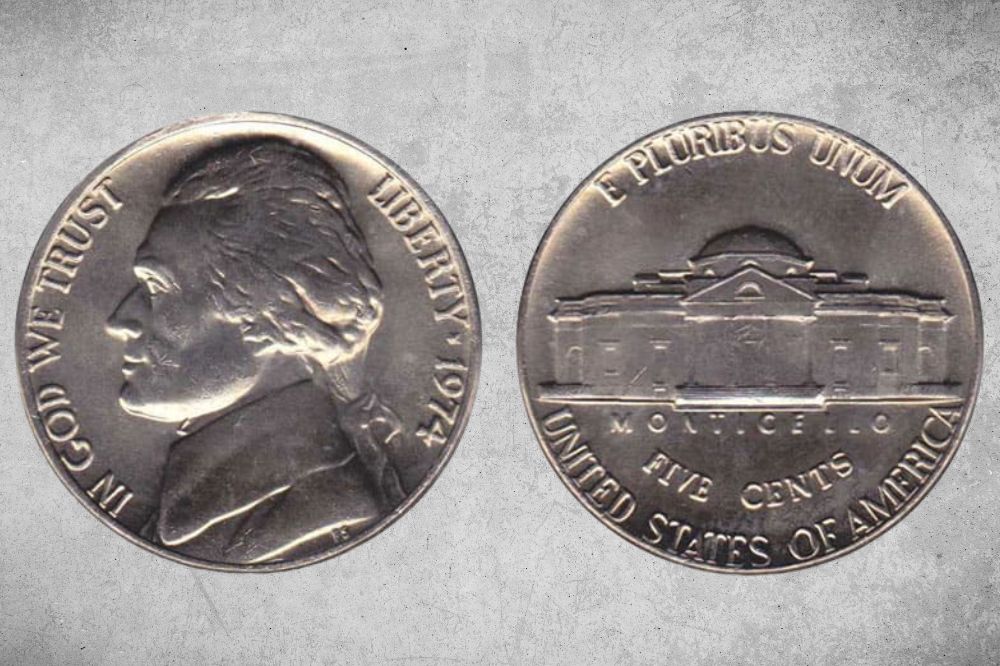If you are attempting to complete a collection of Jefferson nickels, you would be amiss to not include the 1974 nickel. Despite being an insignificant date in numismatics, it is still part of the 85-year run of the Jefferson nickel series.
In this article, we’ll look into everything you need to know about the 1974 nickel, from its value, varieties, history, grading, and prominent errors!
1974 Nickel Value Details
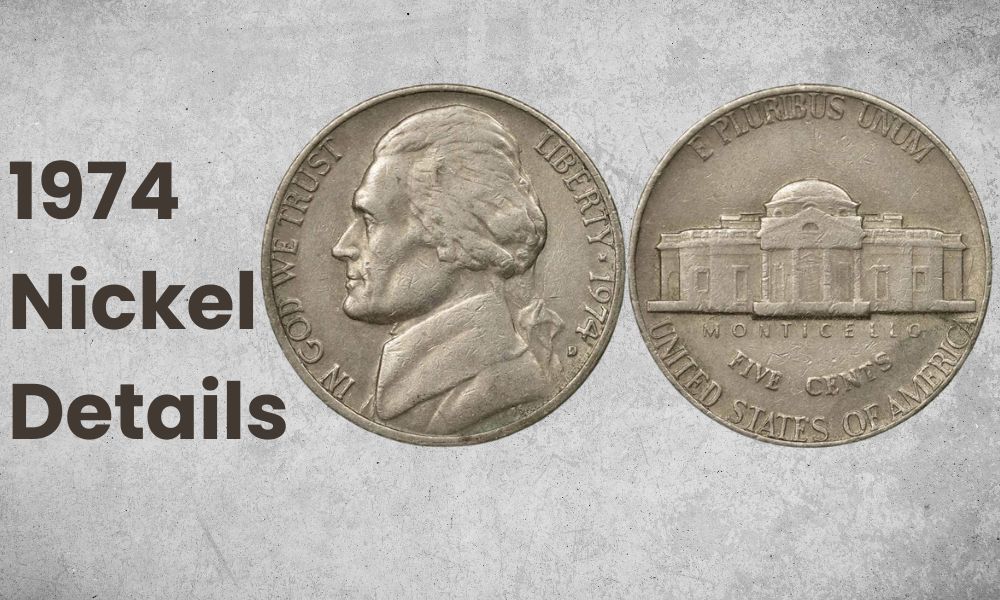
- Category: Jefferson Nickels
- Mints: Philadelphia, Denver, San Francisco
- Year: 1974
- Total Mintage: 881,737,568
- Obverse Designer: Felix Schlag
- Reverse Designer: Felix Schlag
- Edge: Plain
- Diameter: 21.2 mm
- Composition: 75% copper, 25% nickel
- Weight: 5 grams
Also Read: 15 Most Valuable Nickels Worth Money
1974 Nickel Value Chart
| Mint Mark | Good (G-4) | Extremely Fine (XF-40) | Mint State (MS-60) | Mint State (MS-65) |
| 1974 (P) No Mint Mark Nickel Value | – | – | $0.28 | $3.30 |
| 1974 D Nickel Value | – | – | $0.28 | $3.30 |
| 1974 S Nickel Value | – | – | – | – |
1974 Nickel Values and Varieties
1974 P No Mint Mark Nickel
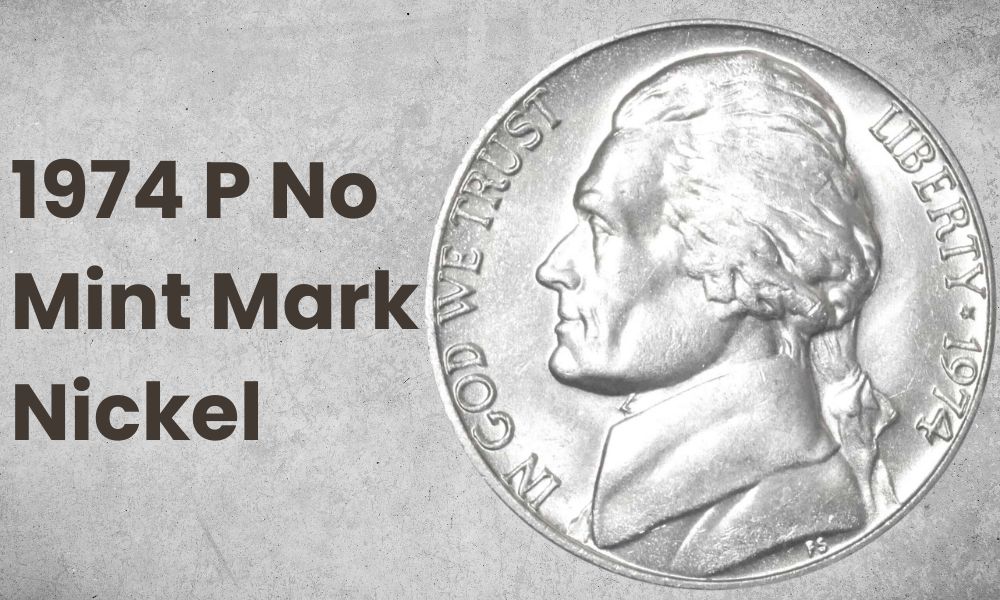
- Type: Jefferson Nickels
- Edge: Plain
- Mint mark: None
- Place of minting: Philadelphia
- Year of minting: 1974
- Face value: $0.05
- $ price: $0.28 to $1,000
- Quantity produced: 601,752,000
- Designer: Felix Schlag
The 1974 Jefferson nickels had an abundant mintage, and the Philadelphia Mint led by a large margin. Comprising almost 70% of the entire mintage, the 1974 P coins have a staggering count of over 601 million, and around 30% of those are still surviving today.
With such a high survival count, the 1974 nickel can be found quite easily up until MS-66. However, no MS-67 coin or beyond has been found. Coins with the Full Steps designation, which refers to those coins where at least 5 steps of the Montecillo at the reverse are readily seen, can be found up until MS-67.
In numismatics, abundance is usually inversely proportional to value, so the sheer mintage and survival rate of the 1974 P coins indicate a low value for this issue. Below MS-60, the value of the coin is about twice its face value, at $0.10. Even at MS-65, it’s valued at only $3.30.
FS coins fare a bit better, although they only start to gain considerable value at MS-66, where they’re valued at $1,000. The highest grade found on these issues was an MS-67 FS, which also holds the current auction record for this coin at $4,230.
1974 D Nickel
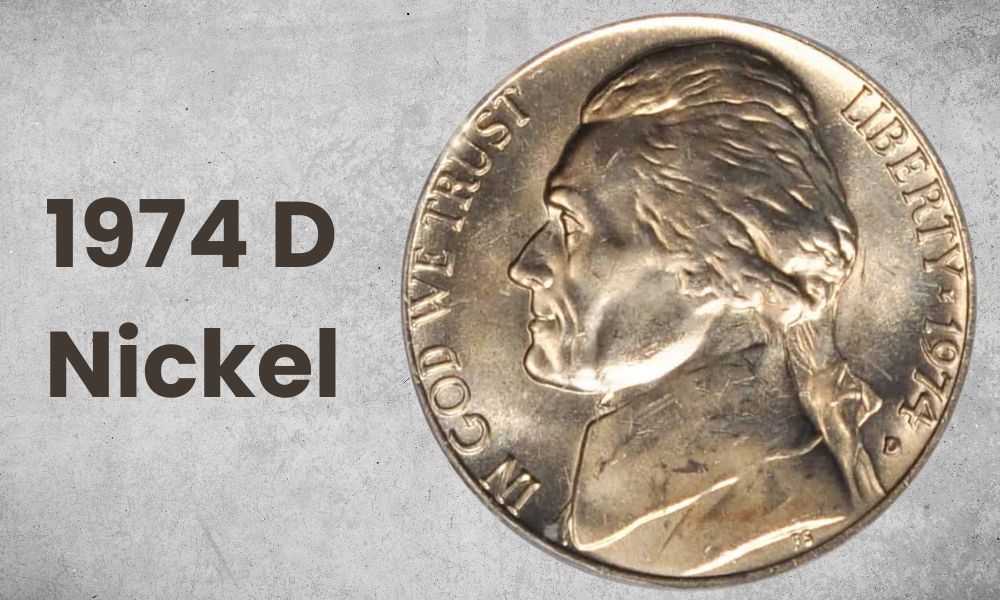
- Type: Jefferson Nickels
- Edge: Plain
- Mint mark: D
- Place of minting: Denver
- Year of minting: 1974
- Face value: $0.05
- $ price: $0.28 to $2,100
- Quantity produced: 277,373,000
- Designer: Felix Schlag
400 million coins shy from the Philadelphia mintage, the Denver mintage is still nothing to snort at, with over 277 million pieces minted. They also sport a high survival rate of 40%.
This means that these coins are common and easy to find up until MS-66. Beyond MS-66, they become scarce to find, although you might eventually find one and be able to buy it for a low price. FS coins are also scarce at MS-66, and they become very expensive at MS-67 and above.
Similar to the 1974 P dime, their high mintage is detrimental to their valuation. The 1974 D nickels are priced at around $0.10 until MS-60 and priced at $125 for MS-67. Curiously, non-FS nickel peaks higher at $2,100, while FS nickel is priced at $1,750, although the grade of the non-FS nickel is higher by one step (MS-67+ vs. MS-67).
The current auction record of the 1974 D nickel is also a non-FS MS-67+ piece, at $1,645.
1974 S Nickel
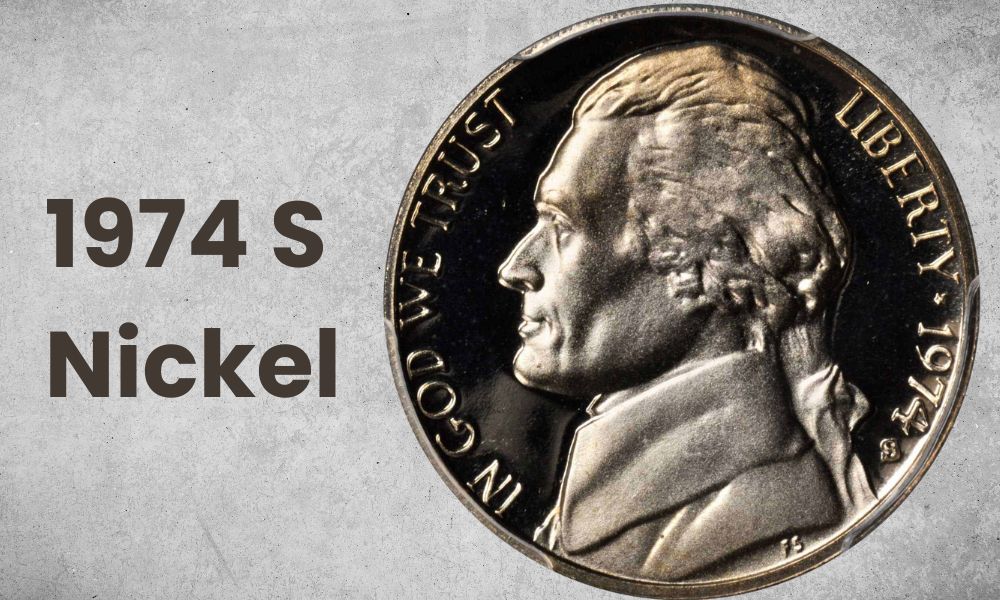
- Type: Jefferson Nickels
- Edge: Plain
- Mint mark: S
- Place of minting: Denver
- Year of minting: 1974
- Face value: $0.05
- Quantity produced: 2,612,568
- $ price: $2 to $25
- Designer: Felix Schlag
Barely holding a candle against the other mintages, the San Francisco mintage consisted purely of proof coins, specifically produced for coin collectors (numismatists). It should come as no surprise, then, that their survival rate is incredibly high with over 80% still readily available.
Since these coins were never released into circulation, the 1974 S nickels are maintained at very high-grade conditions by numismatists. Ironically, this makes them incredibly easy to obtain up until PR-69. Even the Cameo and Deep Cameo varieties, which indicate the amount of contrast between the field (raised design) and the field (background), are relatively easy to find.
Because they are readily available from coin collectors, the 1974 S nickels are fairly easy to obtain and quite inexpensive, too. A PR-63 is estimated to be only $2, and PR-69 is around $15. For the better varieties, a PR-69 CA will only set you back by $20, and a PR-69 DCAM by $25.
However, a perfect PR-70 piece is incredibly rare, especially the Deep Cameo variety. The current auction record for the 1974 S nickel is one such coin, priced at $3,819.
Also Read: Top 110 Most Valuable Nickels Worth Money
1974 Nickel Special Grading Designations
Full Steps
Much like other coins, the Jefferson nickels are not just graded by their condition, but also by certain desirable characteristics of the coin. Numismatists are especially interested in the steps at the base of the Montecillo depicted on the reverse of the coin.
The original design depicts six steps on the Montecillo, and so coins retaining these steps without any error or disturbance are eligible for the Full Steps designation. Major coin grading agencies usually only consider MS-60 coins and above for this designation.
Additionally, PCGS created a finer designation, the 5FS and 6FS designations. As you might surmise from their titles, the 5FS designation is given when at least 5 full steps are distinct and identifiable on the coin, while 6FS is the regular criteria.
These varieties command a higher premium than the other coins, although the difference is not very significant until we reach the scarce MS-67 coins. The current auction record is the same record holder for the 1974 P nickel, at $4,230.
Cameo and Deep Cameo/Ultra Cameo
The proof coins minted by the San Francisco Mint give way to certain designations unique to these coins. Proof coins are generally considered to be coins with very good strike quality that retain design detail very well.
Despite that, there are still varieties among them that are prized higher. Cameo refers to the amount of contrast between the raised design, called the relief, and the background called the field.
If the cameo effect is significant enough, they are given the Cameo designation. Coins with the Cameo designation often exhibit a mirror-like finish to the field and a frosted finish on the relief.
If the cameo effect is intense enough to be distinct from a Cameo coin, then they are given the Deep Cameo (PCGS) or Ultra Cameo (NGC) designation. The telling difference between a regular Cameo coin and a DCAM/UC coin is the amount of frostiness on the relief. A DCAM/UC coin needs to have an intense frosted finish on its devices for it to qualify.
Note that the DCAM/UC designation is only given when both sides exhibit these qualities. When only one side has intense frostiness while the other has a regular Cameo effect, it is simply designated as a CA coin.
Also Read: Top 19 Most Valuable Jefferson Nickels Worth Money
1974 Nickel Value History
The 1974 nickel is part of the Jefferson nickel series, which started minting in 1938 and is still being minted today.
Around 1938, the Buffalo nickel, also called the Indian Head nickel, was due for a redesign after 25 years of mintage. Although the design was well-regarded and beloved even until today, during its run on the mints, it proved to be a hard design to completely impress on coins, sporting a high rate of die breakage.
Once the mandatory 25 years of service was over, the US Mint was quick to replace the nickel with a new design. Then-President Franklin Roosevelt was fond of the Founding Father Thomas Jefferson, so the design for the next nickel was to honor the Founding Father.
The design was decided through a competition, where competitors were to submit coin designs including the likeness of Thomas Jefferson and Montecillo, his residence. Among 390 entries, Felix Schlag, a German immigrant, won the contest, after having President Roosevelt’s blessing for his design.
Originally, the nickel’s composition was 75% copper and 25% nickel. However, at the onset of World War II in 1942, the US Mint changed the wartime nickel composition to 56% copper, 35% silver, and 9% manganese. They switched back to the original composition in 1946, until today.
1974 Nickel Value Grading
Collectors utilize a coin grading scale to judge the condition of a coin. This scale goes from 1 to 70, but it is often simplified into qualitative categories, like Good, Fine, Almost Uncirculated, and Mint State.
For non-proof coins, you might also want to check for the Full Steps designation. Two varieties are available, the 5FS and the 6FS, which you can check on the base of the Montecillo on the reverse of the coin. For proof coins, you can check for the Cameo and Deep Cameo designations, referring to the frostiness of the relief.
You can check the YouTube video below on how to grade Jefferson nickels.
Lists of 1974 Nickel Value Errors
1974 over 1973 Nickel Error
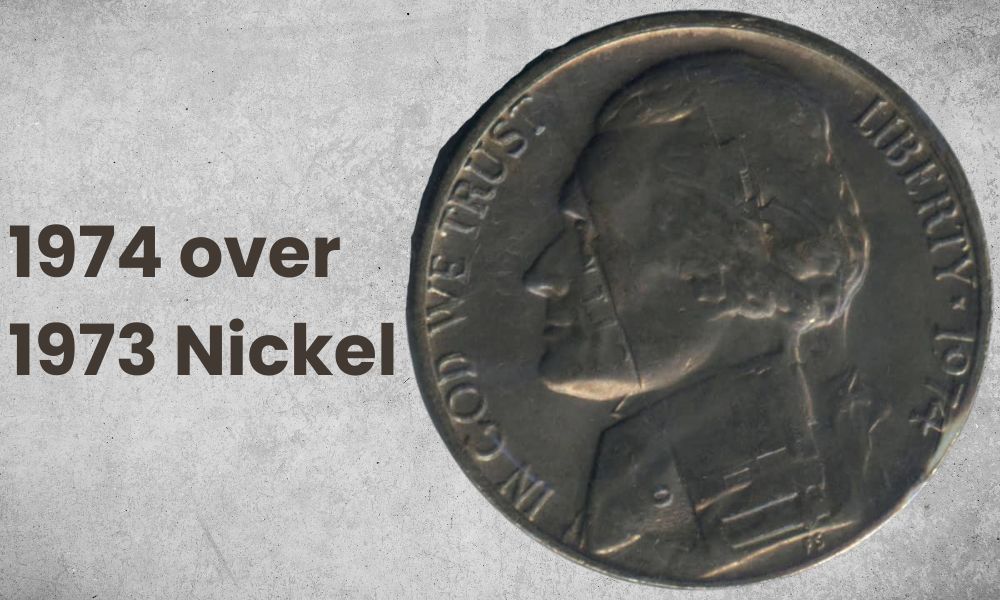
Only two to three Jefferson nickels were known to have the specific error of being struck twice by a die of a different year. Such an error was found on a 1974 nickel, where markings of a 1973 die were found on it.
This error is truly peculiar because not only was the coin double-struck and rotated 90 degrees but the reverse die of the 1974 nickel was struck on the obverse side of a 1973 nickel. You can see hints of “1973”, usually on the obverse, at the end of “E PLURIBUS UNUM”, found on the reverse.
By 2010, the set that included this Jefferson nickel was valued at $15,000 to $17,500 by the authors of the book “100 Greatest U.S. Error Coins.”
1974 Nickel Value Value FAQ
Is a 1974 nickel rare?
Given the high total mintage of Jefferson nickels during 1974, you can easily find these coins in all conditions until MS-66. Even at MS-66+ and above, they may be scarce but you can still readily find sellers and get them for cheap prices.
FS varieties may prove to be quite the rarity, although they are still readily available if you take your time searching for them.
The same is true for proof coins minted in San Francisco. They are even more readily available due to many of them having been able to survive today. You can easily get them at low prices, too, until PR-69. CA and DCAM/UC varieties are also easy to find.
Is the 1974 nickel worth anything?
If you are looking for 1974 nickels with a significantly high value, then you will have to look for certain varieties. Standard 1974 Jefferson nickels with a grade of MS-66 or lower are valued cheaply on the market.
1974 nickels start to be worth a significant amount when they have a grade of MS-66+ or higher. Their value also increases if they are FS-certified. With such conditions, these nickels can be worth more than $1,000.
What kind of nickels are rare?
Being only around 50 years old, 1974 nickels are plentiful in all conditions except the higher grades. Therefore, they wouldn’t be generally considered rare, except for certain varieties.
Most nickels that are considered rare are those nickels minted before the Jefferson nickel, which are usually the Buffalo nickel, which the Jefferson nickel replaced in 1938, and the Shield nickel, the nickel issued from 1866 to 1883.
Are older nickels worth more?
Certain varieties of the Jefferson nickel, such as key dates and prominent errors, are worth a lot. However, for the most part, the current Jefferson nickel series is not worth more than its face value by a lot.
Older nickels, such as the Buffalo nickel, the Liberty Head nickel, and the Shield nickel, are worth more due to their age (around 100 years old or older) and low survival rates.
